Kobo Aura One
The Android flagship of e-readers

Like the best underdog success stories, Kobo’s new flagship e-reader pinpoints the gaps in Amazon’s armour and drives a stake through them. The Aura One is a powerful, progressive reading device that beats Amazon’s offering on size, features, and price.
The question is whether or not that actually makes it a better e-reading device, and the answer is more complicated than a “yes” or “no”.
Different Philosophies
If you want to understand the difference between Kindle and Kobo products, it helps to think of them as Apple versus Android. The Kobo Aura One is like the Android flagship of the e-reading space, and the Oasis is an iPhone.
The Kobo just does more.
The Aura One introduces adjustable colour temperature—a first for reading devices—and seamless integration with the OverDrive lending technology that powers just about every library system in the world. It integrates natively with Pocket for reading articles later. It makes using custom fonts as easy as dropping them into a folder. If there’s something you want to adjust, chances are the Aura One will allow you to do so, and with more granularity than any equivalent Kindle capability.
Similarly, Kobo delights in revealing the limits of Kindle’s software and hardware advances, in ways both big and small.
For instance, all Kobo devices show the cover of your current book (or the title of your in-progress Pocket article) when they’re asleep. This is such an obvious feature that it would seem unworthy of mention if not for the fact that Kindles don’t do it. Despite years of pleading from users, Amazon insists on showing you a random image when the device is sleeping.
Why? Because screw you, that’s why.
Physical Characteristics
When it was first handed to me, my first impression of the Kobo Aura One was that it feels like a tablet rather than an e-reader. It’s large enough to cross the threshold in my brain into the same realm inhabited by the iPad Minis and Nexus 9s of the world.
It’s a transition that many have been asking for since the demise of the experimental Kindle DX. The appeal of an e-reader with a larger screen is pretty obvious.

A Larger Screen
While Kobo has held a screen size advantage for some time now (the Aura H2O boasted a 6.8″ screen compared to the 6″ on all Kindles), they’ve pushed this advantage further with the Aura One.
At 7.8″, the Aura One’s screen is the largest on a modern e-reader, while retaining the 300dpi pixel density we’ve come to expect. It is without a doubt the most beautiful screen on any e-reader on the market. No contest.
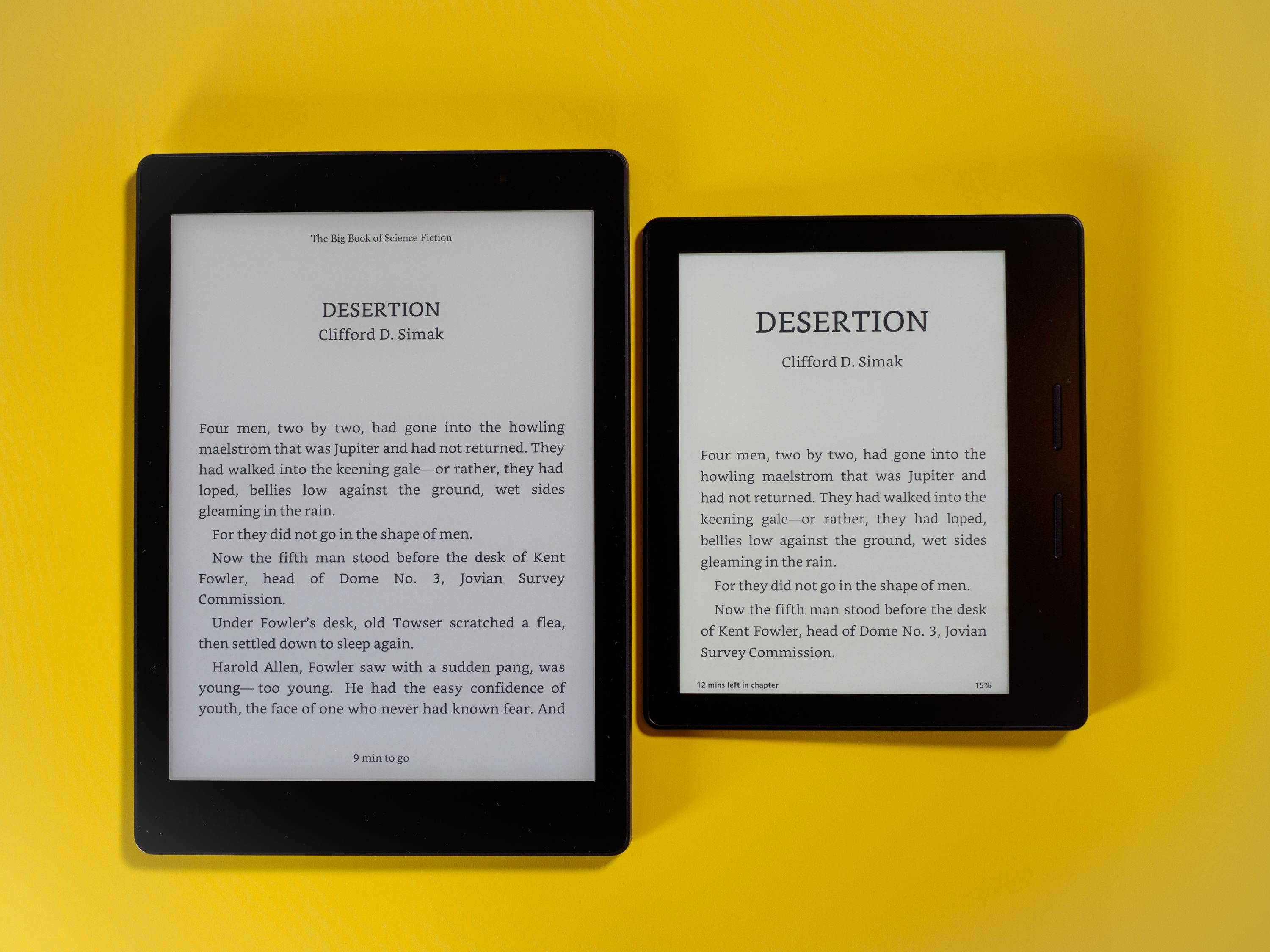 Besides highlighting the size difference and how much extra text you get on the Kobo Aura One (left), this image also shows that the screen is actually a bit dimmer at full brightness than the Kindle Oasis’ (right).
Besides highlighting the size difference and how much extra text you get on the Kobo Aura One (left), this image also shows that the screen is actually a bit dimmer at full brightness than the Kindle Oasis’ (right).
It features a similar front-lit system as before, but this time the lighting array is made up of 16 LEDs. For context, the Kindle Oasis has ten, and the Voyage six. This is a perfect example of a metric where higher numbers do not equate to better real-world performance though.
The Aura One’s 16 LEDs produce a gorgeous, even light distribution across the screen, but only at daylight (cool white) colour temperatures. As soon as you push into the yellower evening colours, the alternating LED colours reveal themselves and you get a distinct pattern of beams along the bottom of the screen.
I’m not typically bothered by the evenness of e-reader lighting (within reason), but on the Aura One it’s noticeable enough to be distracting. If you’re the kind of person who’s bothered by uneven lighting, you’re going to have a bad time with the Aura One at night.
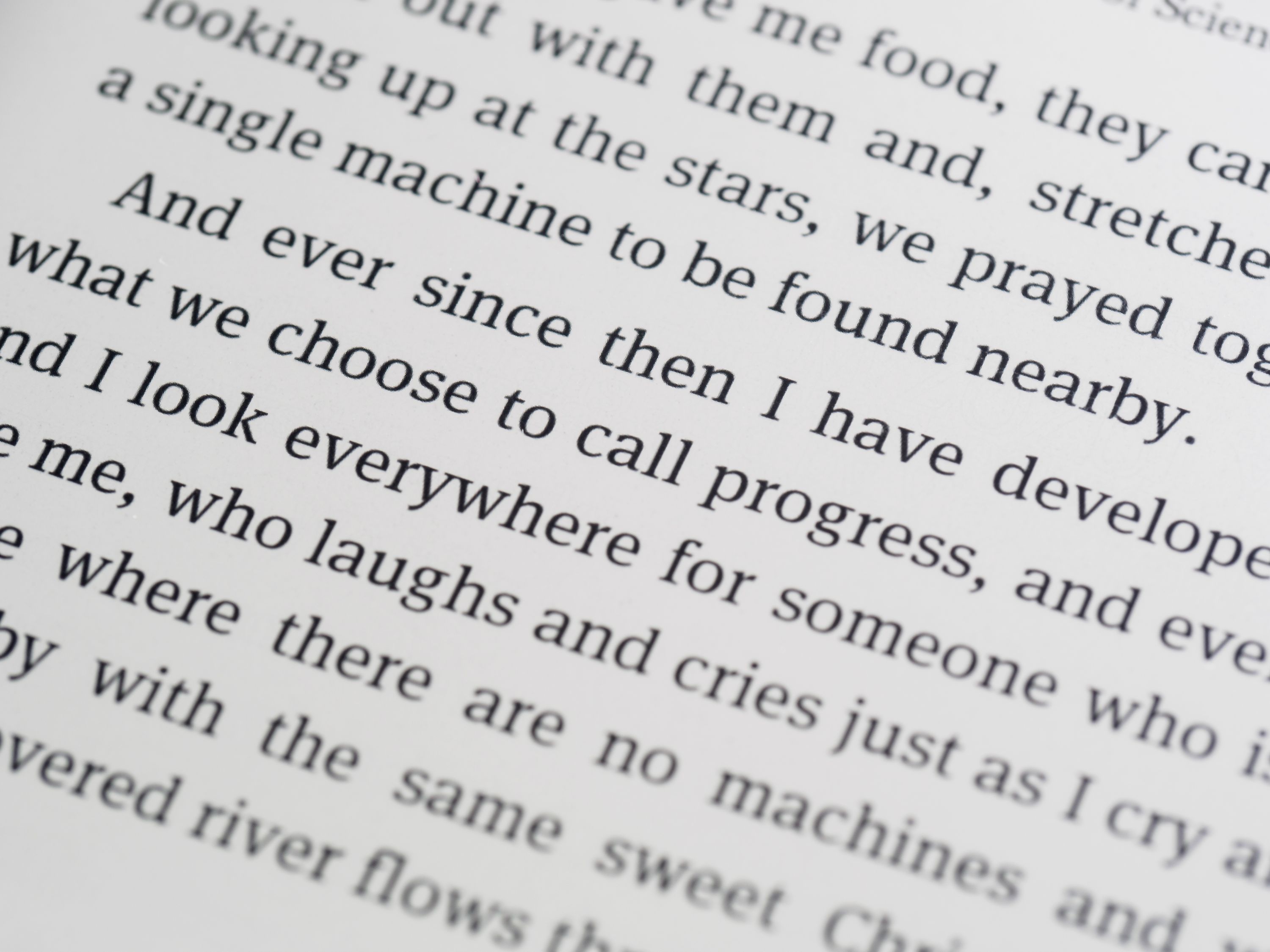 The Aura One is better than ever at rendering text. Letters are crisp, detailed, and accurate, showcasing your font of choice at its best.
The Aura One is better than ever at rendering text. Letters are crisp, detailed, and accurate, showcasing your font of choice at its best.
That being said, the simple fact that you can warm up the colour temperature in the evening is wonderful. There’s some debate about whether or not this actually impacts sleep, but my eyes seem happier.
While the ComfortLight PRO is designed to automatically adjust brightness and colour temperature, I found the implementation unreliable. There were several instances where the change just didn’t occur, despite my “bedtime” being set correctly, and when it did it made the change abruptly rather than progressively changing temperature toward the evening.
I turned it off after the first week and resorted to manually adjusting brightness and temperature.
 The Kobo Aura One (top left) features a larger screen, but thinner bezels and less weight than its predecessor, the H2O (bottom right).
The Kobo Aura One (top left) features a larger screen, but thinner bezels and less weight than its predecessor, the H2O (bottom right).
Design & Form Factor
A larger screen requires a larger body, but the Aura One pulls off the illusion of being lighter despite its comparatively huge size. In fact, it is lighter than its direct predecessor, clocking in at 3 grams less than the H2O. It reminds me of the transition from iPad 4 to iPad Air—same general form factor but much thinner.
Unfortunately, it’s still almost twice the weight of the Kindle Oasis, and heavier than even the Paperwhite. It seems silly to get hung up over a few grams, but these are the kinds of things you feel over the long term with a device that you hold for hours, sometimes even above your head while reading in bed.
Given the size, I appreciated the textured rubber on the back. It makes the Aura One easy to grip. Overall it feels durable, but not “premium”. The Oasis and Voyage manage to give off the impression of slightly superior material quality, which is something that may or may not be important to you.

This is also reflected in the spartan aesthetics; the H2O’s interesting back-plate angles gave it a more sophisticated look despite the recessed screen. The Aura One looks exactly like you would expect an e-reader to look. A few flourishes like the bright blue power button and square charging light do little to elevate it beyond the generic. This, of course, has no impact on its utility, but it’s worth noting considering the amount of money these things cost.
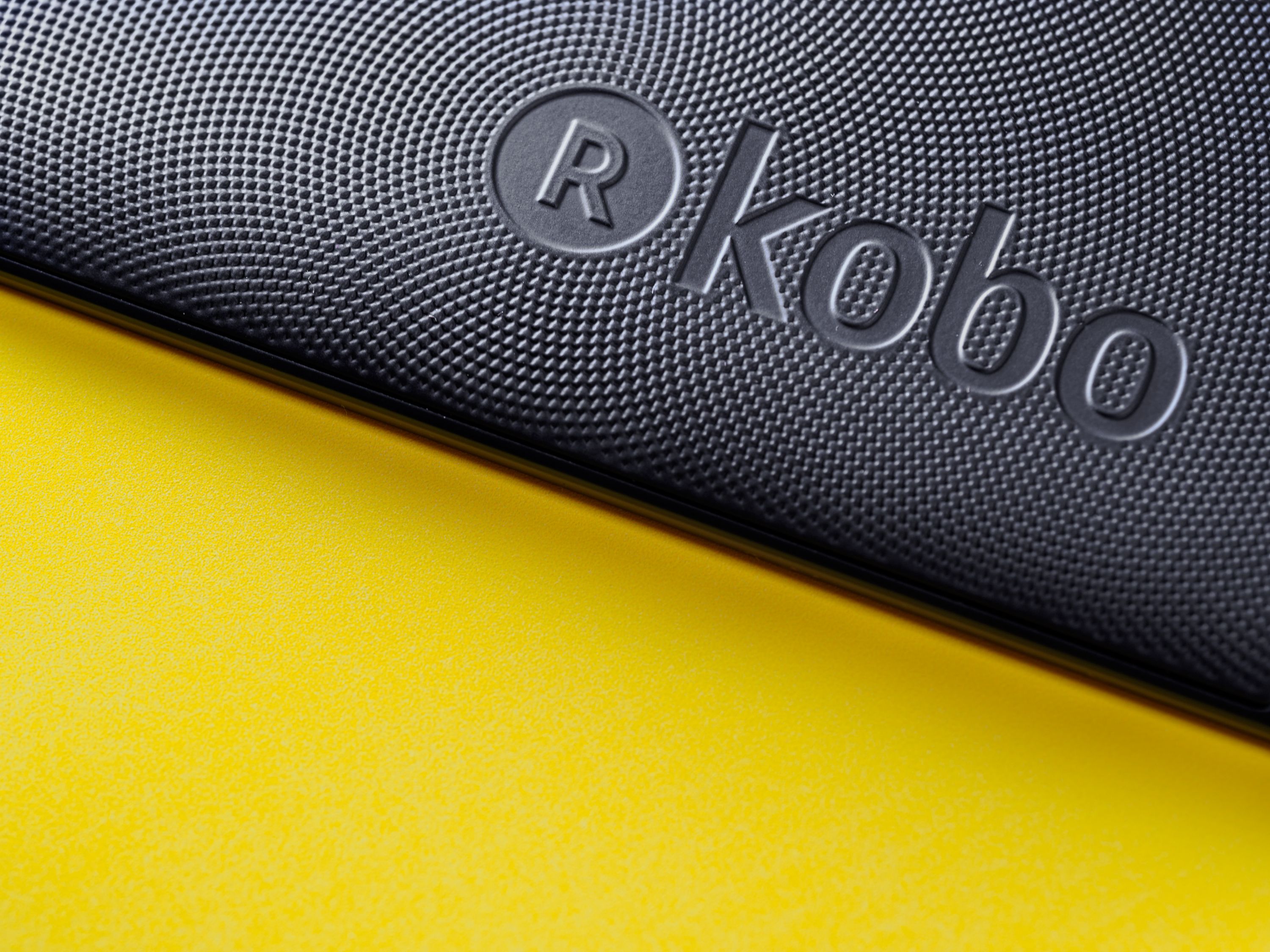 The new logo and textured back are nice, but the Aura One doesn’t draw attention to its design. It’s a subtle, somewhat generic look, for better or worse.
The new logo and textured back are nice, but the Aura One doesn’t draw attention to its design. It’s a subtle, somewhat generic look, for better or worse.
Bigger is Not Better
Initially, I found the Aura One’s size luxurious. Fewer page turns needed! Lots of screen real estate! After about a month though, the novelty wore off and I was left confronting an inescapable reality: this thing is kind of…awkward.
Maybe it’s just me, but part of the appeal of ebooks is that they aren’t as bulky as their hardcover counterparts. I didn’t leave print books behind to replicate their form factor in a digital replacement. When I get lost in a book, I get lost in the book—I don’t notice page turning mechanisms, or front-lighting evenness, or font options. It’s just me and the story.
 This gets uncomfortable very quickly.
This gets uncomfortable very quickly.
What I do notice is how hard it is to hold the Aura One above my head when reading in bed at night; how uncomfortable it gets to wield one-handed, even for someone with large hands; how tempted I am to fiddle with all the typography settings instead of just sitting down and reading my damn book.
To me, the core appeal of an e-reader is the removal of all friction, all distraction. There are certain situations where a larger screen makes more sense: catering to those with failing eyesight, for example, or showing some mercy to the poor idiots who try to read PDFs on these things (I maintain that all e-readers are terrible at this—buy a tablet, people!).
For everyone else, I strongly believe that Amazon’s approach to size has more merit. Even the Paperwhite is pocketable, easy to hold for long periods of time, and light enough to make you forget it’s there.
None of those things are true of the Aura One, I’m afraid.
Battery Life
Part of the appeal of e-readers for me is the absence of battery anxiety. The simple fact that battery life is measured in weeks instead of hours is refreshing.
It doesn’t feel like technology, it just feels like reading.
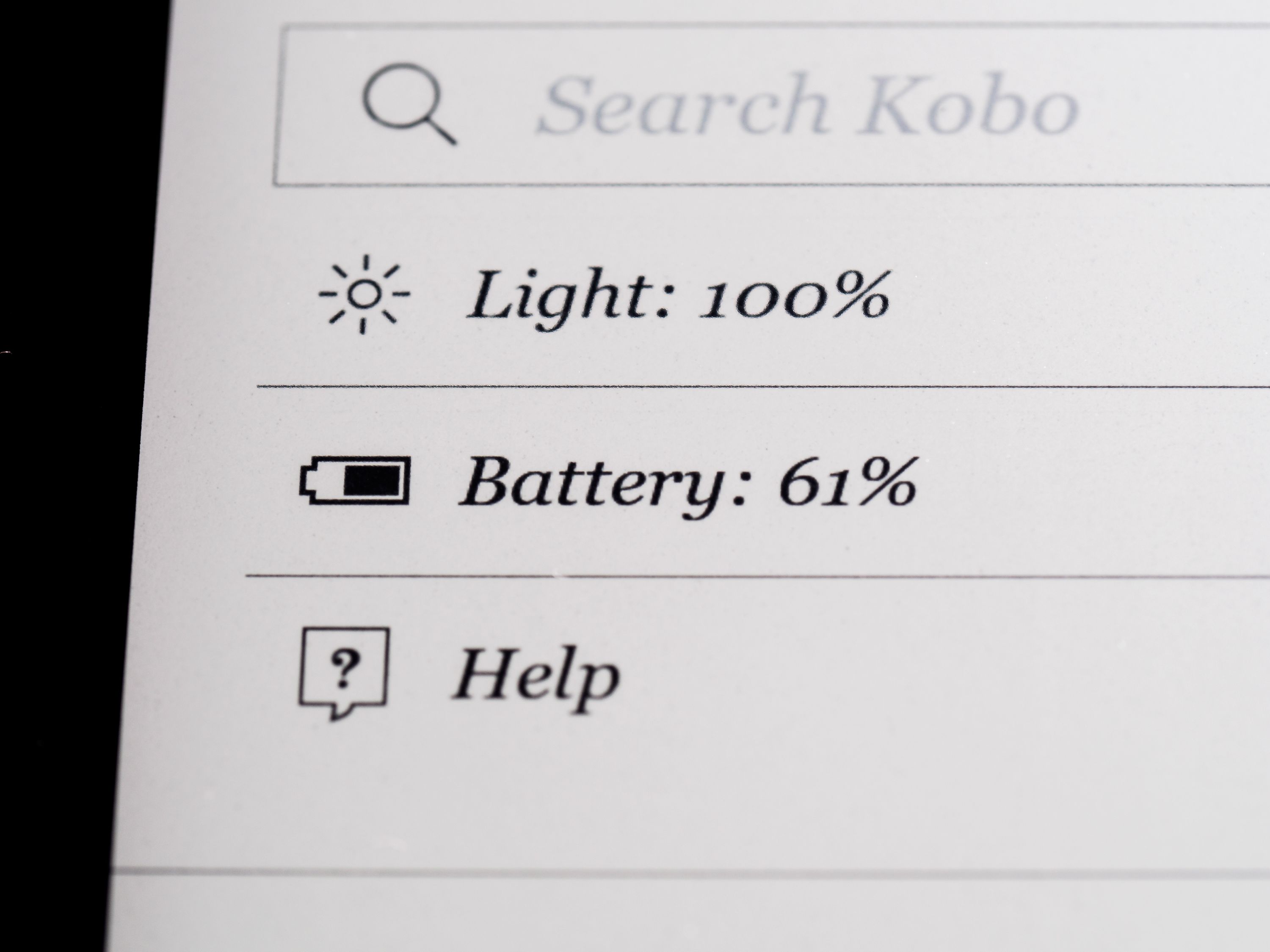
I could bore you with detailed rundowns of battery performance, but we both have better things to do so here’s the verdict: with at least an hour of reading every day, brightness levels no higher than 60% for half of it and below 20% for the evenings, and WiFi left on, I’ve been charging the Aura One about once a week. And it hasn’t been depleted at that point, I just plugged it in out of habit and because I had an opportunity to do so.
If you read less frequently and turn WiFi off, I can easily see this stretching to the one month that Kobo claims. Either way, it’s more than enough to alleviate any battery concerns, especially since it charges quickly.
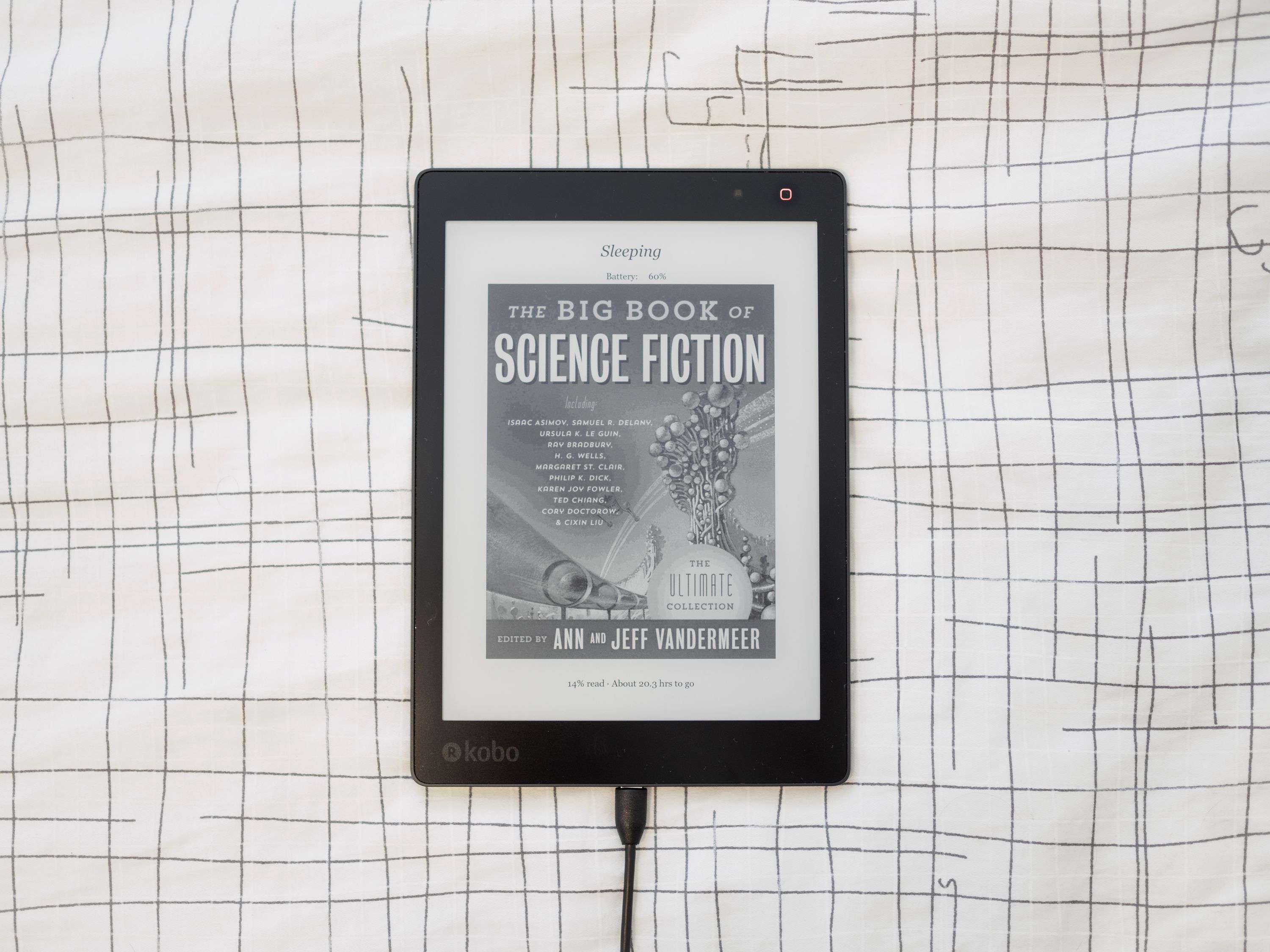 Charging is quick, but you won’t have to do it very often.
Charging is quick, but you won’t have to do it very often.
Waterproofing
The Aura One improves upon the H2O’s headlining feature with an impressive IPX8 rating. This means it’s waterproof for up to an hour in 2 metres of water.
I still don’t care about this.
So far my best use of the waterproofing has been scaring family members by “washing” the Kobo. Granted, that’s a lot of fun, but I have yet to encounter a real-world scenario where I’ve needed it. For the record, I do some pool/beach reading and I haven’t sustained any water damage on any of my Kindles. I don’t know if I’m just unusually careful (a distinct possibility) but either way it’s not something that I consider necessary.
Nevertheless, it’s a hugely popular feature and remains unique to Kobo, making it distinctive if not appealing to me personally. But the Aura One also has some software tricks up its sleeve that set it apart from the competition.
Software
Kobo’s operating system has remained relatively unchanged over the past few years. It’s attractive, efficient, and intuitive. In terms of performance, I’ve always detected a slight sluggishness in Kobo devices compared to their Amazon counterparts, but usually in non-essential areas like returning to the home screen. And you really won’t notice it unless you compare the two side by side.
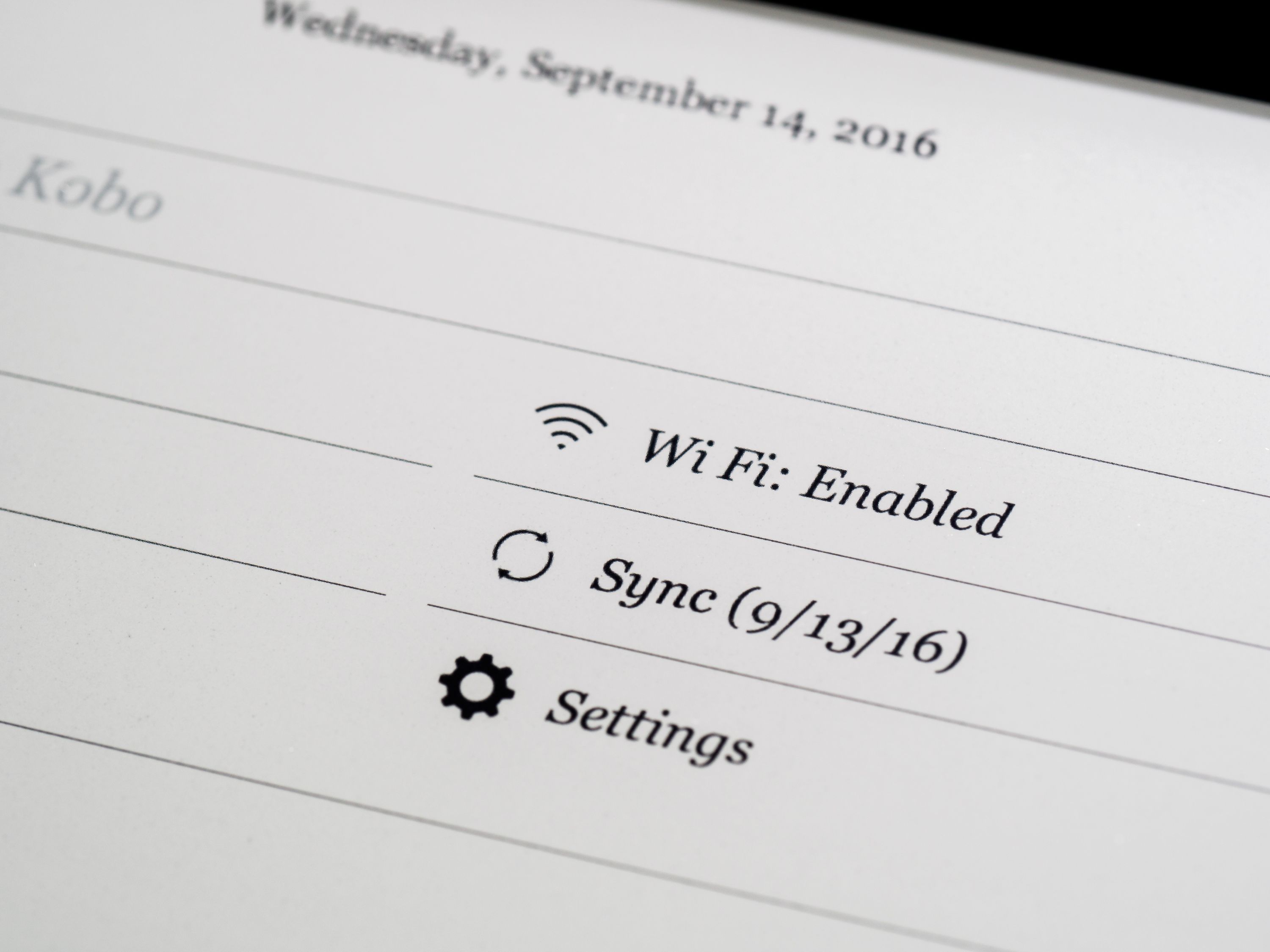 Sync, page turns, and menu navigation are a bit slower on the Aura One than the Kindle Oasis, but the difference is impossible to notice unless you’re comparing them directly.
Sync, page turns, and menu navigation are a bit slower on the Aura One than the Kindle Oasis, but the difference is impossible to notice unless you’re comparing them directly.
The Aura One does one key thing very well: it wakes from sleep quickly. For most people, that’s the single most significant factor in how fast they perceive the device to be. Even more so than page turns, a fast wake makes resuming your reading session feel just as fast as opening a book back up.
Buying & Renting
When it comes to buying books, both Kobo and Amazon make it easy (and Kobo matches prices so the cost is a non-issue), but Amazon has an ace up its sleeve: its review ecosystem. I find that tremendously helpful for informing purchase decisions, and there’s just no comparison. Amazon book listings are teeming with reviews, and Kobo’s are…not.
The main addition to the Kobo software this time around is OverDrive integration for easy library book loans.
For many readers (more than I expected, to be honest), the library is their main source of reading material, even digitally. The process for getting library books onto your device is tedious though. It’s worse for Kindle owners, but even Kobo users had a lot of steps to go through.
Since Kobo’s parent company, Rakuten, bought OverDrive, it was only a matter of time until they made the two play well together. The result is the Aura One’s biggest selling point. Renting a book from the library is now as easy as buying a copy from the Kobo store.
This is a big deal and I’m convinced that it’s going to sell a lot of units.
Whether or not it’s enough to pull people entrenched in Amazon’s ecosystem over to Kobo remains to be seen, but for prospective buyers who have no existing allegiance it’s going to make Kobo that much more tempting. I hope they decide to update the firmware of older devices with this capability as well.
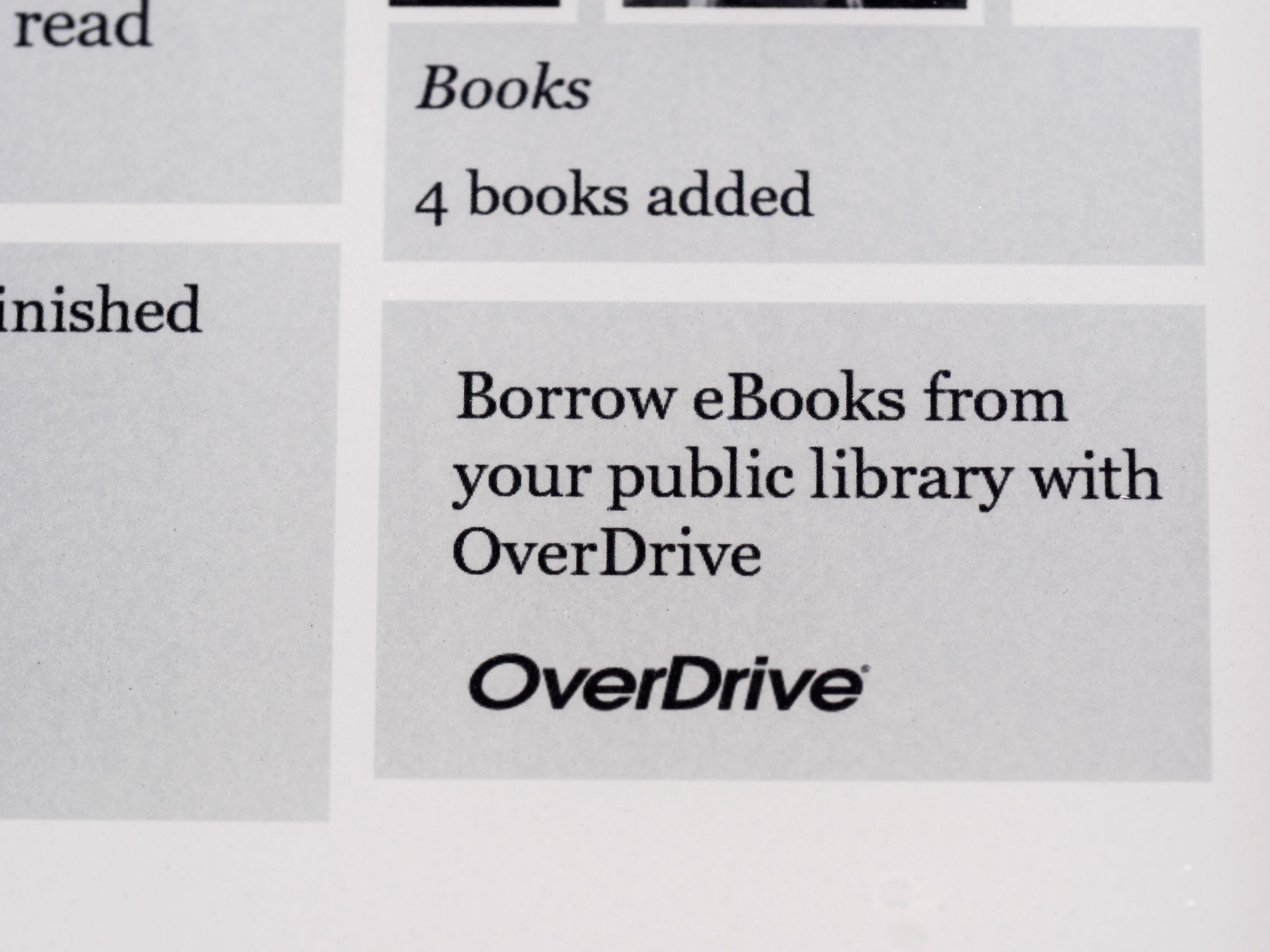
Earlier I described the fundamentally different philosophy behind the software design of Kobo and Kindle. Kobo is happy to give readers plenty of features and ways to customize their experience so that it’s just the way they like it—an appealing prospect.
But all this openness and functionality comes with some serious consequences.
The Crashes
In my review of the Kobo Aura H2O, I noted the absurdly long time it took for the sync process to complete. Sync is still slower, and it differs from Kindle sync in that it’s a scheduled affair rather than a reactive one. Think “Push” versus “Fetch” for emails.
But over time, I’ve realized that slow sync is only sometimes the case. Slow sync seems to be a symptom of a glitch of some sort that, unfortunately, also occurs on the Aura One.
You can tell it’s coming.
The responsiveness of the brightness sliders will drop from “great for e-ink” to “bad slideshow”, and the Pocket integration will stop working. You’ll refresh, knowing you added new articles, and it won’t find them. The settings will indicate a sync is in progress, but you’ll be unable to cancel it.
I put the Aura One to sleep in this state at night with 83% battery life remaining, and woke up to a dead e-reader.
Whatever strange, battery chewing loop state causes this, it seems to be a firmware problem. The most recent post-release firmware update may have fixed this as I’ve not encountered it since, but it’s been too short a time period to say definitively at this point.
There’s also a more common crash that I encountered that appears to be triggered by images in Pocket articles. I haven’t been able to determine what exact kind of image is the problem though, because I’ll get through dozens of articles with images large and small, even animated GIFs, without issue. Then one seemingly-normal article will suddenly put a halt to page turns and freeze the device so firmly that I have to restart it.
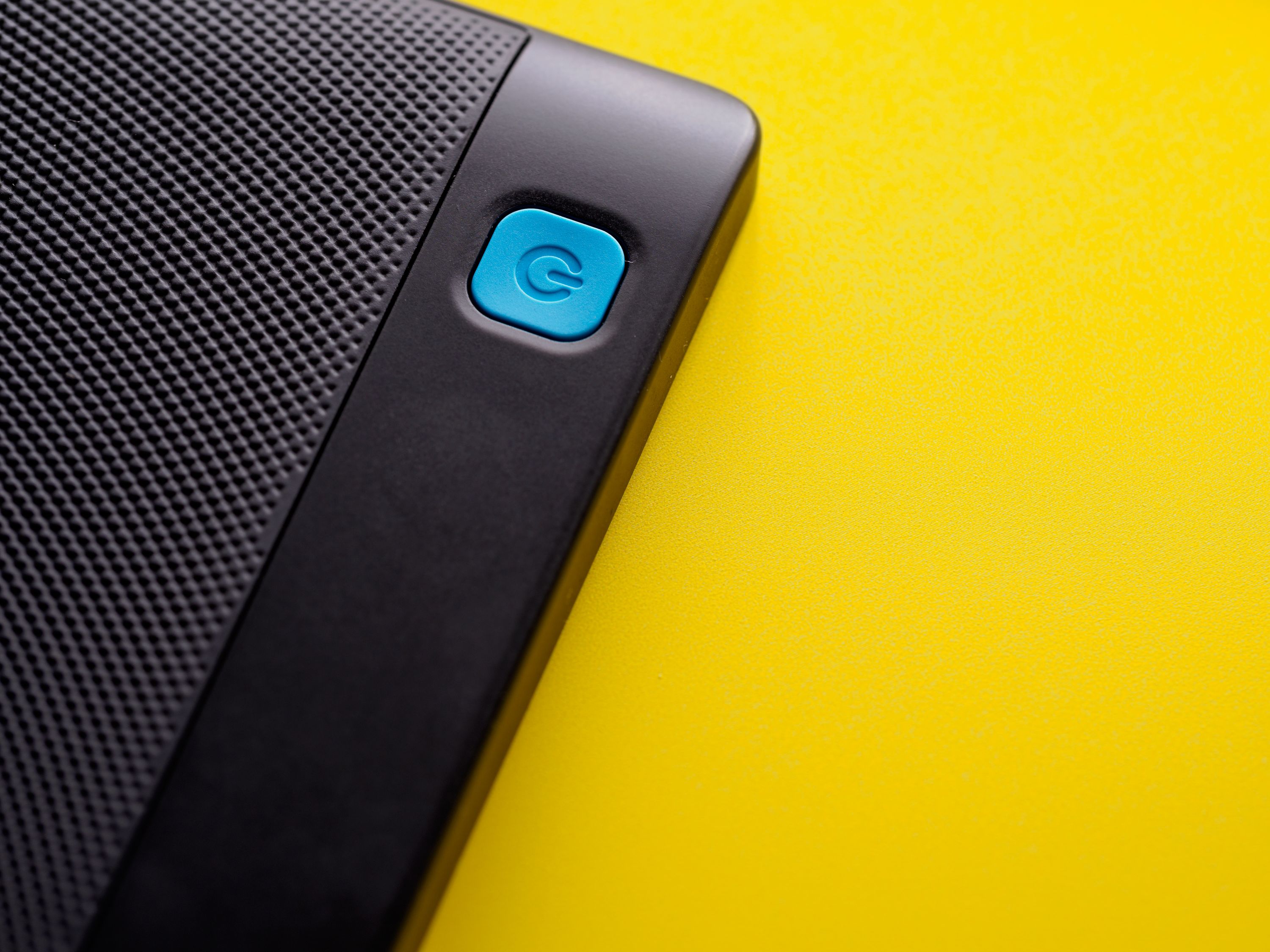 If you do end up having to restart the device, the power button is easy to find. The bright blue is part of Kobo’s new branding, soon to be reflected across its entire product line-up. It’s eye-catching, that’s for sure.
If you do end up having to restart the device, the power button is easy to find. The bright blue is part of Kobo’s new branding, soon to be reflected across its entire product line-up. It’s eye-catching, that’s for sure.
I know to do that, and it’s not the end of the world, but this kind of software glitch is devastating to a normal consumer’s experience, especially if they aren’t tech savvy. If you want to replace paper books, you have to make sure the alternative doesn’t crash.
I have yet to crash a Kindle—of any kind, for any reason. And the sluggishness you’ll sometimes see flipping pages in Pocket articles with images is nowhere to be seen on Kindle devices displaying those same articles. That, of course, is anecdotal evidence, but it also reflects the experience of the folks who have written to me about their e-reader choices in response to my Kindle vs. Kobo article, as well as the folks in my life who own one or the other family of device.
Pocket Problems
I was nothing short of effusive in my praise for the Pocket integration that Kobo offers, and I remain delighted by its presence.
Still, it’s only fair to point out that the functionality has not kept up with the times. Pocket has evolved a robust system for recommending articles, but the Kobo integration still doesn’t support it. It’s frustrating because if there’s any place I’d like to share notes and links to interesting reading material, it’s Pocket (or Instapaper). Not Facebook.
I’ll leave you to guess which one is possible on the Aura One.There’s also the lingering issue of highlights, which remain trapped on the device. I enjoy highlighting passages for future reference or quoting in articles, but unlike my Kindles, which make these highlights available online or via a simple text file on the device, Kobo highlights are inaccessible outside of the device unless you share everything to Facebook.
These are small complaints, and ones that are specific to the way I like to interact with my reading material, but they’re exactly the sorts of straws that make camels look up their neighbourhood chiropractor.
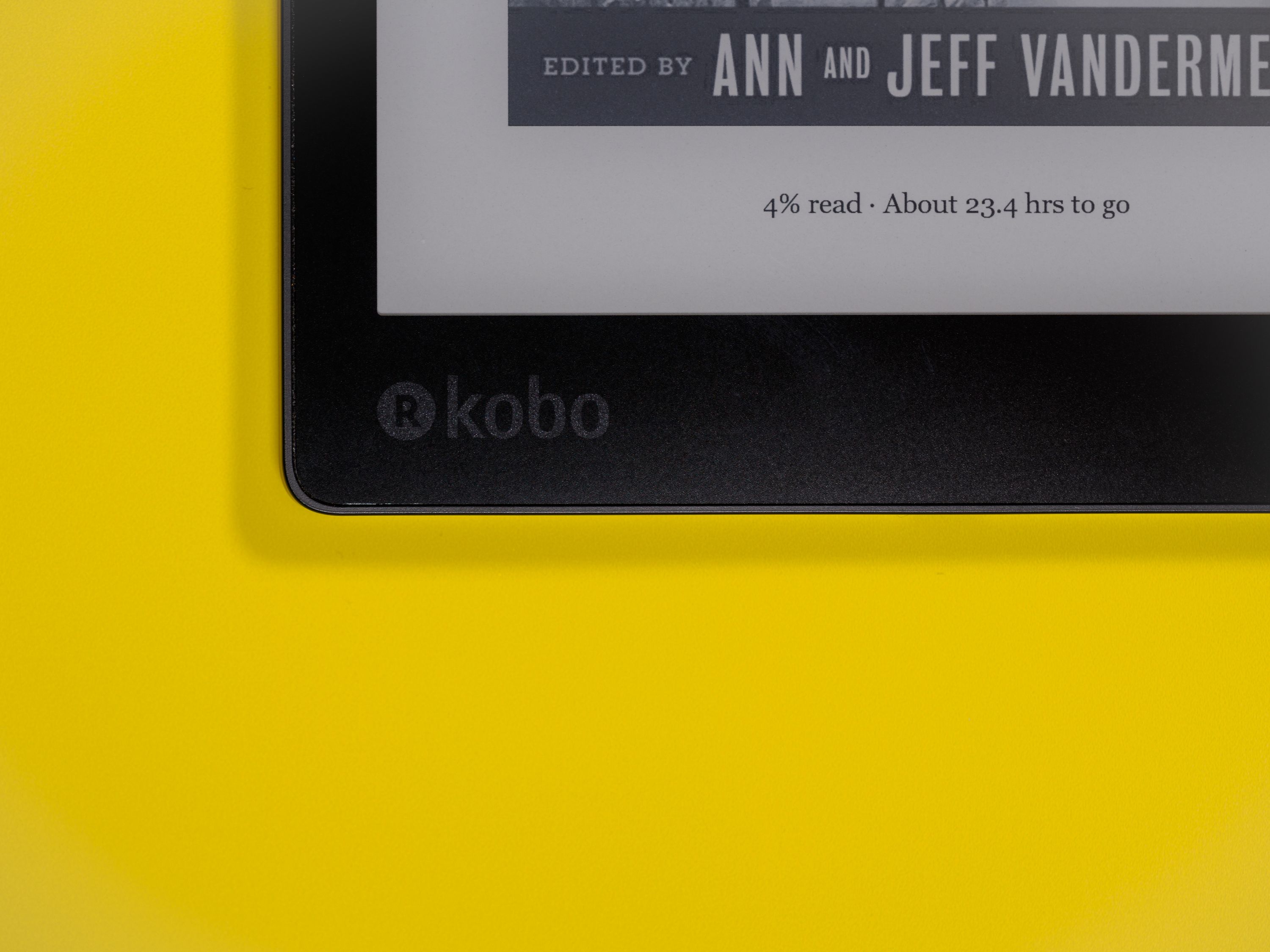 The Aura One, like all Kobo devices, displays your reading progress and book/article cover on the screen while it’s asleep. Such a convenient, helpful affordance…looking at you here, Amazon.
The Aura One, like all Kobo devices, displays your reading progress and book/article cover on the screen while it’s asleep. Such a convenient, helpful affordance…looking at you here, Amazon.
Convenience Features
I want to wrap up with some discussion of the Aura One’s convenience features. I’m making that term up to encompass several bits of design or functionality that aren’t necessarily a core part of the Kobo experience but are worth knowing about as you make your purchasing decision.
Last year, I asserted that the Kobo dictionary functionality was inferior to the Kindles’. Over the past few months, I’ve stopped running into instances where the Kindle dictionary had an entry that the Kobo one didn’t, so either my initial findings were a fluke or the Kobo dictionary has improved.
Either way, one important difference remains: Kindles have a brilliant translation feature that allows readers whose first language differs from the content language to not only look up word definitions, but also translate entire passages via Bing Translator. While this isn’t applicable to me, I recognize it as a significant selling point that Kobo can’t match.
Conversely, Kobo has a Reading Stats module that can be a lot of fun. It tracks your reading, as you might expect, offering insights into average session length, number of page turns, average time per page, books completed, and total reading hours. This works in concert with the built-in “Awards” (think game console achievements but for reading) to serve as a strong motivator, perfect for encouraging kids to read. Its only downside is that for some reason it doesn’t count books side-loaded via Calibre in its finished book statistics. It will count everything else—page turns, session length, etc.—but no matter how many books you complete, it always reports 0 books finished.
Kindles count reading stats and grant awards as well, but only via the FreeTime module, which is designed for kids.
Kobo’s ‘Beyond the Book’ functionality is no longer present, which is a shame because I would have liked to see them build it out into something like Kindle’s X-Ray features.
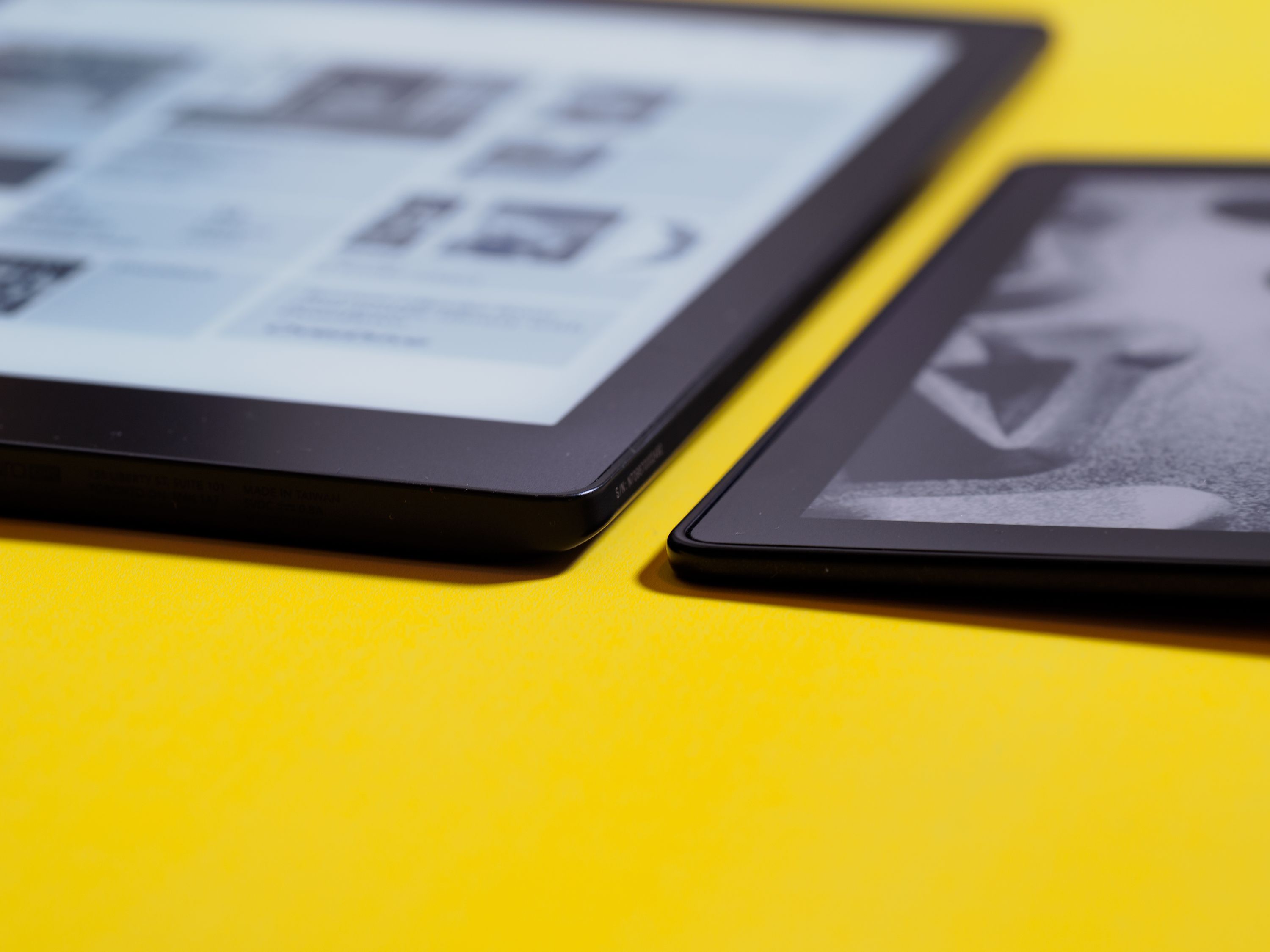 The Kindle Oasis (right) is not only significantly smaller in shape, it’s also thinner along its tapered edge. The button side is about the same thickness as the Aura One (left).
The Kindle Oasis (right) is not only significantly smaller in shape, it’s also thinner along its tapered edge. The button side is about the same thickness as the Aura One (left).
Lastly, I found myself hoping that Kobo would find a way to bring 3G connectivity to the Aura One. This is one of those things that seems like an impractical show of muscle by Amazon, but I actually find it a lot more useful than waterproofing.
For example, I add articles from my iPhone to Pocket throughout the day. The Kobo tends to sit in my bag while I’m out, ready for a quick reading session. But if what I want to read is a Pocket article—which is often the case when I don’t have a lot of time—I can’t get those articles downloaded onto the Pocket unless I’m in a WiFi zone or take the time to tether to my phone.
Similarly, I often keep a lot of samples on my e-readers so I can try new things. If I happen to get to one of them while I’m traveling, I usually finish it and decide I want to read the rest of the book. On my 3G-equipped Kindles this is a one-tap process. On the Aura One and other Kobo devices, I’m out of luck until I get to WiFi or, again, do some tethering.
Aura Won?
When it first arrived, I was convinced that the Aura One is a slam dunk: a clearly superior device built for book lovers. And that is still largely true.
However, what I’ve found over the past month and a half of exclusive Aura One reading is that those initial impressions are tarnished by the realities of everyday use. Especially coming from a Kindle. Physically holding and reading on the Aura One is less comfortable than on the Kindle Oasis, Voyage, or Paperwhite, especially when lying down. The Voyage paired with its Origami case remains the best for that by far.
The Aura One’s size is a double-edged sword. Fewer page turns makes for a great marketing message, but unless you count page turns that’s not what you notice in the long run; you notice not being able to fit it into the kinds of pockets and pouches you could fit your smaller e-reader into.
For someone like me who prefers buying books to renting them, the OverDrive appeal is lost. Furthermore, the absence of a healthy review ecosystem keeps me buying those books on Amazon and then transferring them over to the Kobo.
On the other hand, the Pocket integration remains as compelling as ever, and there simply isn’t a workflow as elegant on Kindle devices. Similarly, the colour temperature adjustment is wonderful and I’m willing to forgive the unevenness of the lighting when using the warm settings.
The result is a conflicted impression of Kobo’s flagship.
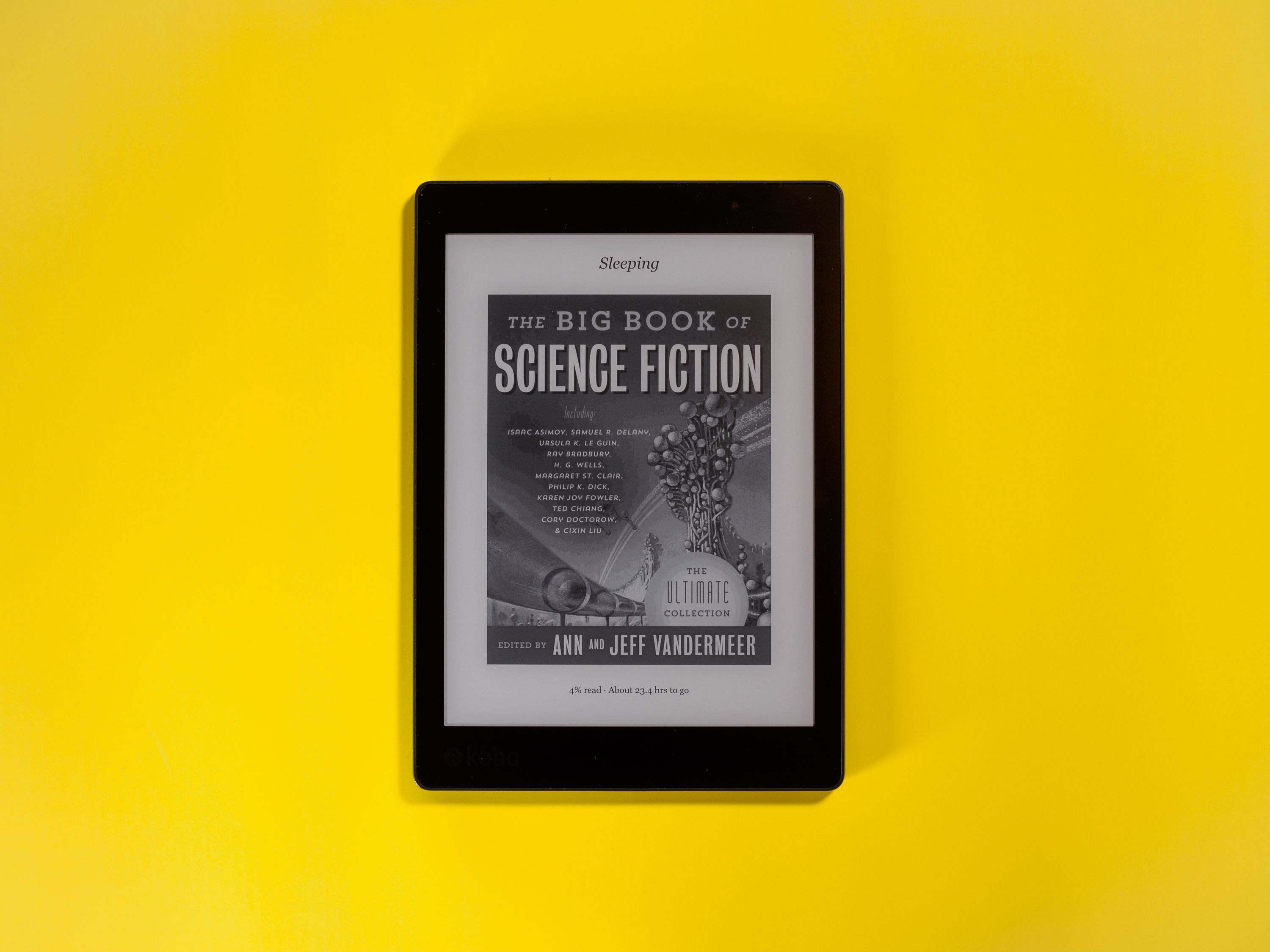 So should you buy a Kobo Aura One? It depends where you’re coming from.
So should you buy a Kobo Aura One? It depends where you’re coming from.
Recommendations
Viewed through the lens of a Kindle owner, the Kobo makes three major new claims to superiority: size, colour temperature adjustment, and library integration. Only one of those improves upon the reading experience for me, and the size is actually a step in the wrong direction for my preferences.
I would miss the Amazon ecosystem too—reviews, highlights, X-Ray, lending library, Family Sharing in the US, etc.—and while the Pocket integration is a huge argument in Kobo’s favour, I can replicate the functionality on a Kindle without giving up its advantages.
Approaching it from the perspective of someone brand new to e-reading, the Aura One is an amazing choice. It offers more bang for your buck than either of Kindle’s high-end models, and if you happen to enjoy tweaking your reading experience then you’ll be very happy.
On the other hand, if I had a family member who wanted a reading device, especially one who isn’t very tech savvy, I would shy away from recommending the Aura One. It’s too fiddly, and many of the appealing features are the sorts of things you come to appreciate after you’ve owned an e-reader for a while. I’m not convinced they’re meaningful to new users.
Lastly, there’s the existing Kobo user. They are the only folks who get my unequivocal recommendation to upgrade. Especially if your device is older than the Aura generation, you’ll find the Aura One to be a transformative leap forward on every front, as long as you don’t mind the size.
Wrap-Up
The final consideration is price. The Aura One retails for $250 CAD, compared to the Kindle Voyage’s $300 ($370 with 3G) and $400 Kindle Oasis ($500 with 3G). That makes it literally half the price of its official rival.
At this point, I have to step back and remind everyone that 95% of you should buy the normal Kobo Aura Edition 2 (or Kindle Paperwhite) for about $140 and spend the rest of the money on books.
Seriously.
The remaining 5% who are willing to spend more for the absolute best reading experience can think back to the Android vs. Apple comparison I made off the top. Yes, the Amazon option is more expensive, but even if the individual device is less capable on paper, you’re buying into an ecosystem that may offer a better long-term experience.
If that doesn’t sound important, or if you’re a big library user, or if you don’t care about ecosystem and just want the absolute most feature-packed, customizable e-reader on the market, then there’s only one game in town: the Kobo Aura One.
review technology digital lifestyle